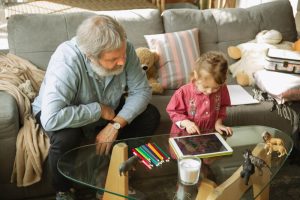There is no cure for Dementia, but you can create a personalized environment to ease the suffering and support the patient!
Dementia is not a single illness; it is a unique condition caused by a combination of chronic diseases and injuries. Dementia patients experience memory loss, inability to think clearly, and difficulty performing daily tasks. Even simple everyday tasks become difficult for the patient to complete independently.
According to a study by WHO, about 55 million people have Dementia, which is a significant cause of disability and dependency among the elder people. It is also the seventh greatest cause of worldwide death rate. So, we must take care of Dementia patients and assist them in finding efficient pain relief methods.
In this blog, we will learn to create a Dementia-Friendly Home and give caregivers practical advice. But before getting started, let’s understand the causes, symptoms, and types of Dementia.
What is the Cause of Dementia?
Dementia is caused by direct or indirect damage to your brain due to diseases, injuries, or any emotional or physical breakdown. Dementia harms the nerve cells in your brain, reducing your brain’s ability to communicate with its various areas effectively. Dementia can also be caused by obstructed blood flow to the brain, which hinders it of oxygen and nutrients. It causes brain tissue to die, causing it to malfunction.
Symptoms of Dementia
Dementia is not an individual illness; it is a result of several diseases and injuries that directly or indirectly damage the patient’s brain. So, the symptoms of Dementia vary according to the cause of its type. Some common symptoms are:
Cognitive Changes:
- Memory Loss
- Difficulty in Communication or Finding Words
- Getting Lost While Performing Daily Tasks
- Experiencing Confusion Even in Familiar Settings
- Poor Control of Movements
- Poor Emotional Control
Psychological Changes:
- Sudden Personality Change
- Feeling Depression and Anxiety
- Urge Of Agitation
- Inappropriate Behavior
- Paranoia – Being Suspicious
- Experiencing Hallucinations
At the start, patients will only start losing their ability to do daily activities and recognize things. If Dementia worsens, patients will face extreme mood changes and anger issues over ordinary things. Now, let’s shed some light on the type of Dementia.
Categories of Dementia
There are three main categories of this illness – Progressive Dementia, Disorders Linked to Dementia, and Reversible Dementia-Like Conditions.
Progressive Dementias:
These types of dementias aren’t reversible and get worse over time. It Includes:
- Alzheimer’s Disease
- Frontotemporal Dementia
- Vascular Dementia
- Lewy Body Dementia
Disorders Linked to Dementia:
The patient with Dementia linked Disorders suffers from the same symptoms and irregularities.
- Creutzfeldt-Jakob disease
- Huntington’s disease
- Parkinson’s disease
- Traumatic brain injury (TBI)
Reversible Dementia-Like Conditions
These conditions are reversible with proper care and treatment.
- Infections and immune disorders
- Normal-pressure hydrocephalus
- Brain tumors
- Metabolic or endocrine problems
- Low levels of certain nutrients
- Subdural bleeding
- Medicine side effects
How can you Create a Dementia Friendly Environment?
As we know, Dementia cannot be cured. However, by modifying the spaces in a specific setting and adapting to certain lifestyles, we can help patients feel less pain and stress. You must adjust the environment to the patient’s comfort and use ideal settings to remove any kind of triggers. So, here are some tips for creating a Dementia Friendly Home!
-
Lighting and Shadows
Dementia patients can find it challenging to do their daily tasks independently, leading to increased stress levels. The lighting in your home should be brighter so the patient can easily access things.
Add natural light in the daytime to create a soothing and relaxing environment. Your patient can get confused by shadows or reflections, so try to eliminate or cover the mirrors and other reflective items. Make sure to keep the room dark for a good night’s sleep. You can also use light sensors for enhanced safety. Don’t forget the regular eye checkups!
-
Reduce Excess Noise
It is normally observed that people with Dementia hate excessive noise. Use your noisy equipment less frequently. If you have laminate or vinyl flooring, use carpets to reduce the footstep noise. You can also add cushions and curtains to absorb background noises. Take the patients for regular hearing check ups also!
-
Safe Equipment
It is better not to do all of the work for your patient. Let them do some activities independently (if they can). Ensure that the equipment inside your home are safe. Keep your indoor environment clean, as air pollution can increase Dementia.
-
Use Signs and Labels
It is common for Dementia patients to forget about their daily activities and directions. You can add direction signs and instructions on the specific parts of your home. Try to choose a place where your patients usually stay.
-
Outside Settings
Ensure all your outside settings are safe to protect your patient from potential injuries. Try to personalize the outdoor space according to the patient’s preference. You can also add different types of flora and fauna to promote healing.
-
Support Memories
Try not to rearrange too many items in the home. Keep the original setting the same as it used to be. Add photos of your patient’s memories and make different parts of the house easily accessible. This way, your patient will not feel dependent, and their confidence will remain intact.
Advice for caregivers
Most people suffering from Dementia are of the age over 65, and the condition can get even worse with increasing age. You must make professional decisions for their well-being, but never forget to give your patients emotional support. Maintain their energy with daily exciting activities. Find ways to make them happy and remove any negative triggers. Make sure your patient is doing enough physical and mindful movements. Keep them socialized and treat them as if they were a family member.
Conclusion
The type and symptoms of dementia are determined by its root cause. As a result, you cannot approach all patients in the same way. Some people may require mental support, while others may benefit from physical activity. Being a professional caregiver, you must acknowledge your patients’ emotional condition and create an ideal environment for them.
If you’re looking to create a supportive environment or explore professional care options for your loved one with dementia, connect with us today. Together, we can provide the care and compassion they need to thrive.





